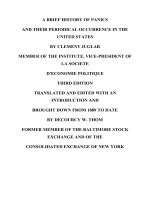Mullan a history of digital currency in the united states; new technology in an unregulated market (2016)
Bạn đang xem bản rút gọn của tài liệu. Xem và tải ngay bản đầy đủ của tài liệu tại đây (2.46 MB, 284 trang )
A History of Digital
Currency in the United States
New Technology in an Unregulated Market
P. Carl Mullan
Palgrave Advances in the Economics of Innovation
and Technology
Series Editor
Albert N. Link
Greensboro, North Carolina, USA
The focus of this series is on scholarly inquiry into the economic foundations of technologies and the market and social consequences of subsequent innovations. While much has been written about technology and
innovation policy, as well as about the macroeconomic impacts of technology on economic growth and development, there remains a gap in
our understanding of the processes through which R&D funding leads
to successful (and unsuccessful) technologies, how technologies enter the
market place, and factors associated with the market success (or lack of
success) of new technologies. This series considers original research into
these issues. The scope of such research includes in-depth case studies;
cross-sectional and longitudinal empirical investigations using project,
firm, industry, public agency, and national data; comparative studies across
related technologies; diffusion studies of successful and unsuccessful innovations; and evaluation studies of the economic returns associated with
public investments in the development of new technologies.
More information about this series at
/>
P. Carl Mullan
A History of Digital
Currency in the
United States
New Technology in an Unregulated Market
P. Carl Mullan
Digital Currency Intelligence Authority Ltd.
White Stone, Virginia, USA
Palgrave Advances in the Economics of Innovation and Technology
ISBN 978-1-137-56869-4
ISBN 978-1-137-56870-0 (eBook)
DOI 10.1057/978-1-137-56870-0
Library of Congress Control Number: 2016957648
© The Editor(s) (if applicable) and The Author(s) 2016
This work is subject to copyright. All rights are solely and exclusively licensed by the
Publisher, whether the whole or part of the material is concerned, specifically the rights of
translation, reprinting, reuse of illustrations, recitation, broadcasting, reproduction on
microfilms or in any other physical way, and transmission or information storage and retrieval,
electronic adaptation, computer software, or by similar or dissimilar methodology now
known or hereafter developed.
The use of general descriptive names, registered names, trademarks, service marks, etc. in this
publication does not imply, even in the absence of a specific statement, that such names are
exempt from the relevant protective laws and regulations and therefore free for general use.
The publisher, the authors and the editors are safe to assume that the advice and information
in this book are believed to be true and accurate at the date of publication. Neither the publisher nor the authors or the editors give a warranty, express or implied, with respect to the
material contained herein or for any errors or omissions that may have been made.
Cover image © A-Digit / DigitalVision Vectors Collection, Getty Images.
Printed on acid-free paper
This Palgrave Macmillan imprint is published by Springer Nature
The registered company is Nature America Inc.
The registered company address is: 1 New York Plaza, New York, NY 10004, U.S.A.
CONTENTS
1
1
Introduction
2
E-gold
19
3
The Liberty Dollar and Bernard von NotHaus
87
4
E-Bullion and Mr. James Fayed
111
5
Crowne Gold
153
6
Liberty Reserve
171
7
IntGold
197
8
OSGold
205
9
GoldMoney
229
v
vi
CONTENTS
10
WebMoney Transfer
245
11
New FinCEN Rules
261
Index
273
LIST
OF
CHARTS
Chart 1.1 IVTS transaction vs digital currency transaction
Chart 4.1 2002 Asset comparison of E-gold.com and E-bullion.com
Chart 4.2 Contact information of law enforcement and regulatory
agencies received by Goldfinger Coin & Bullion, Inc.,
Goldfinger Bullion Reserve Corp. and E-Bullion Co
17
125
146
vii
CHAPTER 1
Introduction
For centuries, people of the world have used cash, such as coins and notes,
as a medium of exchange. When modern economies adopted an electronic
version of money, this government-issued digital value could only circulate through highly regulated banks and financial institutions. This electronic money also became a powerful government tool that provided daily
control over a nation’s money supply.
However, the new Internet delivered innovative methods of creating
private digital versions of currency, along with many advanced methods
for transferring this online value. The Internet’s new decentralized features, protocols, and freedom altered the existing definition of electronic
money and ushered in the concept of privately issued digital currency.
During the late 1990s, Internet entrepreneurs began to experiment
building ingenious new versions of electronic money known as digital
currency. Existing US financial regulations had only supervised and controlled the movement of electronic money through banks and regulated
financial institutions. The new Internet digital currencies were moving
locally and internationally well beyond the reach of US financial regulations and government supervision. In fact, from 1996 through 2006,
some government agencies even had a difficult time identifying and defining these new financial technologies.
© The Author(s) 2016
P.C. Mullan, A History of Digital Currency in the United States,
DOI 10.1057/978-1-137-56870-0_1
1
2
P.C. MULLAN
By 2016, there were thousands of Internet digital currency products
representing money and other value, circulating alongside governmentissued legal tender. In a few regions, the private digital currency has almost
replaced the government’s electronic version. Digital tokens have brand
names, static and changing monetary values, and various features which
directly compete with government-issued money and bank products.
The adoption of new financial regulations in the USA and the restrictive environment created by the new laws forced the closure of many innovative digital currency businesses. Of the nine businesses profiled in this
book that operated between 1996 and 2006, only two are still operating
in 2015. Seven of the digital currency systems were sidelined because of
criminal activity or shut down due to US regulations. The notable exception to being “shut down” or regulated out of the business was e-gold.
While the e-gold operators were convicted of multiple felonies related to
the money transmitting operation and most of the company assets were
forfeited, the business was never forced to close. The e-gold operation
voluntarily closed down.
Only two of the nine companies, which had been early entries in the
marketplace survived the changing rules and unregulated environment.
These were GoldMoney and WebMoney Transfer. Both businesses are discussed in this book. Careful examination of digital currency history suggests why these companies were able to succeed while others had failed.
Beyond these nine businesses, dozens of other digital currency systems and products operated throughout that first decade. However, by
late 2011, strict new financial regulations caused the closure of all digital
currency operations in the USA. The only digital currency products left
circulating through the USA were the newer decentralized cryptocurrencies that operated without a parent company or primary server. By 2012,
foreign corporations engaged in US digital currency business and unwilling to comply with the strict new FinCEN regulations pulled out of the
American market.
Many people and companies have been prosecuted by the federal government and state government for violating laws that related to Money
Service Business and Money Transmitter Licensing. Seven of the nine
companies profiled in this book, along with the business operators, were
directly involved and connected to criminal prosecutions. Analysis of nine
accepted digital currency systems that emerged in the decade between
1996 and 2006 includes the following topics.
INTRODUCTION
3
1. The operators’ motivations for developing the digital currency
system
2. Features, currency design, and the development of exchange
networks
3. Comparisons of early digital currency systems with conventional
bank products
4. Technical structure that permitted the circumvention of existing
US regulations
5. How US government agencies reacted to the new unregulated
technology
6. US financial regulations created to combat the new unregulated
digital currency systems
7. Government actions in the prosecution and asset seizure of the
digital currency company assets
8. Why only two of the nine digital currency companies survived
9. The potential target market of users for each digital currency as
defined by the operators early in their business
10. Identifying actual users along with motivations for using digital
currency
11. What actions the two surviving companies voluntarily took that
ensured the companies’ survival
12. Why digital currency systems and products succeed in consumer
markets and the primary reasons for failure
Digital currency offers many of the same functions of governmentissued money. Digital currency is an efficient medium of exchange. Users
can purchase goods and services using digital currency units. Digital currency is a store of value. Privately issued tokens have a value which can
remain steady over time. Account owners can use online digital currency
as a saving account for the long-term storage of value. Digital units backed
by gold or denominated in a national currency can function as a unit of
account. Digital currency units are modern, recognizable, and measurable
economic units that are familiar in global economies.
When discussing private digital currency, it is important to recognize
that the underlying topic is money. Most users identify privately issued
digital currency as money. People around the world have preconceived
notions of money and how it should function in their life. In modern societies, money is a very intimate topic. Spending habits, debt, credit cards,
and banking are all money topics that are not openly discussed in public or
4
P.C. MULLAN
with strangers. Human patterns and values surrounding money are often
learned as a child and remain with a person their entire life. Consequently,
the introduction of a new kind of private money in a modern society will
be met with resistance. This situation is particularly evident in America.
WHO USES DIGITAL CURRENCY AND WHY?
In the decade that followed 1996, over a dozen new digital currency
systems were introduced to the world. Each system delivered new innovative technology along with exciting commercial features which were
believed to be beneficial for the economy and the population. The first
of these platforms was e-gold. The company’s website described it as
“Better Moneytm.” Compared to fiat paper currency, supporters claimed
that e-gold was faster, cheaper, and safer than government-issued “bank”
money.
The research presented in this book attempts to show the reasons an
entrepreneur operator may have had for creating these digital currency
businesses. The book also asks who used the digital currency and for what
purpose. In understanding these questions, it may be possible to look
ahead and plot a more successful strategy for the future introduction of
new innovative digital currency products.
People with no access to banks or bank products will quickly adopt
digital currency as a substitute for electronic government money and bank
services. Whether the digital currency product is accessible from a cellphone, kiosk, or personal computer, it can immediately replace missing
financial tools typically provided by a bank. In cases where a population
with no bank access adopts a privately issued digital currency unit in place
of bank services, users recognize those units of digital currency as money.
In economies without bank access, a new digital currency should function well for both merchants and consumers. Historically in these environments, customers have used digital currency to purchase goods and
pay for services including phone bills, utilities, food, transportation, local
wages, and medicine. For a population without access to a bank or bank
products, the use of a new digital currency does not replace existing bank
products. In this kind of nonbank marketplace, as users adopt the new
digital currency, they are not required to stop using an existing bank product such as a credit card. These users are entering the digital currency
marketplace because they have no bank alternatives. Because they are not
changing their existing financial habits, only adopting new methods of
INTRODUCTION
5
payment, these populations should quickly and easily accept the new type
of digital currency. In this economy, it is expected that both merchants
and consumers will quickly accept the new digital currency product.
Two illustrations of newly adopted digital currency innovation are
Kenya’s MPESA and Russia’s WebMoney Transfer. In Kenya, a lack
of bank access caused the population to embrace cellphone digital payments. MPESA mobile payments provided services the banks could not
offer. There was no competition for the private currency products offered
through MPESA. Although a bank had not issued the digital units, the
community quickly began to identify them as money. In Russia, a broad distrust of banks, which started in 1998, created a cash-based economy. While
Russian banks were still in operation after 1998, a large part of the population did not trust or use the banks. This community was open to accepting
a new digital currency product that would replace bank services. There
was a genuine need for this financial product. WebMoney Transfer started
offering private digital currency tools that replaced the bank’s untrusted
system. In both of these past cases, digital currency was successfully introduced and quickly adopted by a population of nonbank users. MPESA
offered digital currency services to those with no bank access in a cashbased economy. WebMoney Transfer provided a substitute private digital
currency to people untrusting of banks in another cash-based economy.
Existing populations which do not use banks because of factors such as
cost, religion, distrust, or regulations are excellent markets for the introduction of digital currency products. Also, cash-based economies have
been willing to adopt new innovative digital currency technology. Due to
cultural restrictions, credit card use in the Middle East is small. Countries
with large Islamic populations such as Egypt, Indonesia, and Malaysia
should be ideal places to introduce nonbank digital currency products. In
past years, these consumers have quickly recognized digital gold currency
as a beneficial method of doing business online without the need for a
credit card or bank.
Anywhere, participation in a market requires the adoption of an exclusive digital currency product, may also lead to a large new group of users.
Markets, where access and participation requires a particular digital currency, can be illustrated by the activity taking place in Dark Markets on
the hidden parts of the Internet. The anonymity of shopping for illegal
drugs on a Dark Market website requires that the user pays using bitcoin
or another cryptocurrency. Participation in this market requires bitcoin
digital currency.
6
P.C. MULLAN
WHAT IS DIGITAL CURRENCY?
Digital currencies are privately issued electronic units that circulate on
the Internet. Banks do not accept private digital currency as a deposit and
the Internet currencies are not legal tender. The units have brand names
such as “Digital Grams,” “Evos,” “Gold Grams,” “e-currency,” and many
others. Acceptance of this digital medium of exchange is 100 percent voluntary. The private companies and individuals that created the original
digital currency products were also free to define the unit’s commercial
value. To build value into a digital unit, many operators permanently
matched physical assets with the units. The industry described most digital currencies as being “backed by” an asset. Examples of these are digital
currencies backed by gold, silver, dollars, and euros. In the case of bitcoin,
some users describe it to be “backed by” computer processing power.
While each digital currency had a different brand name, all of these
privately operated systems faced similar issues relating to the unregulated
market environment. The decade from 1996 through 2006 allowed anyone, with or without previous banking experience, to introduce a new
digital currency financial product to the global consumer marketplace.
This book investigates and attempts to define characteristic features shared
by all new digital currency products and further tries to identify common
issues each business encountered.
Distinctive features of digital currency:
1. All transactions are final, irrevocable, and irreversible.
2. Digital currency units can be bought or sold through a third-party
independent agent.
3. During a transaction, there is no requirement to return or exchange
the digital units through the original issuer.
4. Digital currency is freely exchangeable for other digital currency
units through a third-party independent agent.
There are nine digital currency businesses profiled in this book which
circulated between 1996 and 2006.
1.
2.
3.
4.
e-gold
E-bullion
Liberty Dollar (eLibertyDollar)
Crowne Gold
INTRODUCTION
5.
6.
7.
8.
9.
7
Liberty Reserve
IntGold
OSGold
GoldMoney
WebMoney
NEW US FINANCIAL REGULATIONS
Two US financial regulations changed the global digital currency marketplace and forced existing digital currency businesses to exit the US market.
1. On July 21, 2011, FinCEN published a Final Rule amending definitions and other regulations relating to money services businesses
(the MSB Rule).1
2. On July 29, 2011, FinCEN issued a Final Rule on Definitions and
Other Regulations Relating to Prepaid Access (the Prepaid Access
Rule).2
Legal Cases
Key legal cases discussed in this book include:
Case 1:07-cr-00109-RMC
United States of America
v.
E-gold, Ltd.
Gold & Silver Reserve, Inc.
Douglas L. Jackson,
Barry K. Downey, and
Reid A. Jackson,
Defendants.
18 U.S.C. § 1956 (Conspiracy to Launder Monetary Instruments);
18 U.S.C. § 371 (Conspiracy);
18 U.S.C. § 1960 (Operation of Unlicensed Money Transmitting
Business);
D.C. Code § 26-1002 (Money Transmitting Without a License)
18 U.S.C. § 2 (Aiding and Abetting and Causing an Act to be Done); and
18 U.S.C. § 982(a) (1) (Criminal Forfeiture).
8
P.C. MULLAN
Case 2:08-cr-00224-PSG
United States of America
v.
James Michael Fayed,
And Goldfinger Coin & Bullion, Inc.,
Defendants.
A violation of 18 U.S.C. § 1960
Case 3:08-cr-00085-N
United States of America
v.
Michael Comer
Operating an Unlicensed Money Transmitting Business
(A violation of 18 U.S.C. § 1960(a) and (b)(l)(B))
Case 5:09-cr-27-RLV
United States of America
v.
Bernard Von NotHaus,
Defendant.
18 U.S.C. § 371, conspiracy to violate 18 U.S.C. §§ 485 and 486, and
substantive violations of 18 U.S.C. §§ 1341, 485, 486 and 2.
Case 1:13-cr-00368-DLC
United States of America
v.
Liberty Reserve S.A.,
(18 U.S.C. §§ 1956, 371, 1960 & 2)
Arthur Budovsky,
a/k/a “Arthur Belanchuk,”
a/k/a “Eric Paltz,”
Vladimir Kats,
INTRODUCTION
9
a/k/a “Ragnar,”
Ahmed Yassine Abdelghani,
a/k/a “Alex,”
Allan Esteban Hidalgo Jimenez,
a/k/a “Allan Garcia,”
Azzeddine El Amine,
Mark Marmilev,
a/k/a “Marko,”
a/k/a “Mark Halls,” and
Maxim Chukharev,
Defendants.
Case 1:08-cr-00717-JGK
United States of America
v.
David Copeland Reed,
Defendant.
Title 18 U.S.C. §§ 1956, 1343
Case 6:09-cv-01851-JA-KRS
United States of America
Plaintiff,
v.
47 10-ounce Gold Bars, 35 1-ounce Gold Coins, and 3,069 1-ounce
Silver Coins, in rem,
Defendant.
Case 3:03-cv-00955-MA
10
P.C. MULLAN
United States of America
v.
47 10-Ounce Gold Bars et al
18 U.S.C. § 1960, 18 U.S.C. § 981(a)(I)(A).
The book also discusses several other criminal cases and civil actions as
related to digital currency.
BUILDING A BETTER MOUSETRAP
There is an old phrase, generally attributed to Ralph Waldo Emerson,
which says “If you build a better mousetrap the world will beat a path
to your door.” The phrase is a metaphor for the power of innovation. If
a person creates a better product, then the public should naturally want
to purchase the new innovative item. Using this analogy, if government
money is the old mousetrap, then digital currency was the better mousetrap, and consumers around the world should have been rushing out to
use the innovative new digital type of money. In theory, consumers, merchants, and businesses all over the world should have all been adopting
these new digital currency systems. However, the recent history of digital
currency in America tells a different story. While consumers will rush to
buy the newest cellphone technology, a majority of consumers will not
race to use a new and improved version of private money. The markets
of consumer activity where the “build-a-better-mousetrap” rule can be
applied do not include money, payments, or personal finances.
Matters of personal finance are very private consumer issues. In America,
financial payments and banking are almost considered “intimate” topics.
While growing up, US shoppers become accustomed to certain methods
of payment and everyday routines that surround personal financial activity.
This reluctance of US consumers to change their personal spending habits
is particularly relevant when discussing the introduction of new digital
currency products.
In the late 1990s, entrepreneurs and innovators such as Douglas
Jackson and James Turk recognized that government-issued money could
use some improvement. These two gentleman and others were responsible for creating innovative private digital currency systems which emerged
during the decade 1996–2006.
The design of digital currency allowed for widespread global use by
any person with Internet access. Digital currency accounts have no setup
INTRODUCTION
11
costs, no high monthly fees, and no lengthy identification requirements.
Without identification requirements and costs, digital currency should be
accessible and attractive for everyone. Online accounts could be instantly
created and used by anyone from any nation on earth. It is the role of
private digital currency to furnish everyday financial tools to unbanked
persons. By design, digital currency systems are created for use outside of
conventional financial institutions and cater to nonbank customers. Those
persons unable to engage in a financial business through a traditional
bank greatly benefited from the use of private Internet digital currency
products.
However, from 1996 to 2006, Americans did not rush out and adopt
the new and innovative digital currency products. While introducing this
new commercial technology, the company operators had to navigate difficult waters of an unregulated US financial marketplace. Unforeseen US
consumer reluctance to adopt digital currency became a dominant factor;
stalling the growth and acceptance of digital currency in the USA. Beyond
America’s border, populations of nonbank users flocked to adopt this new
version of electronic money.
A LACK OF EARLY DIGITAL CURRENCY REGULATION
When any new technology enters the consumer marketplace, it can take
the government several years to adjust regulations that control the use of
that new technology. This statement is especially so regarding new financial products. In 2015, the government is trying to catch up with the
massive popularity of personal drones. As millions of new unregulated and
unlicensed drones take to the skies, the Federal Aviation Administration
(FAA), which is part of the US Department of Transportation, has been
busy writing new laws and regulations that will catch up with this new
technology. A very similar situation occurred in 1996 with new private
digital currency systems and agents. When commercial digital currency
emerged in 1996, this new financial product was not recognized or identified by existing US financial regulations. No existing US laws defined
a digital currency system, a digital currency exchange agent, or a digital token backed by gold. No judge had ever rendered an opinion on
the topic, and no individual had been prosecuted for breaking the law as
it related to financial transactions and digital currency. Just like the new
drone technology, digital currency that circulated online was a brand-new
technology. Throughout that first decade, it was believed that a digital
12
P.C. MULLAN
unit transferred online was not considered money transmitting because
it did not involve government-issued cash or currency. The government
regulations did not yet recognize the movement of privately issued digital
currency as transmitting legal tender. Operators of digital currency systems in the USA openly discussed the topic. No one at that time could
definitively say that circulating a private digital currency units over the
Internet was a financial activity that required government supervision or
a license. No regulatory agency had yet defined the operation of a digital
currency company as a money service business. Consequently, without any
supervision or regulations, the digital currency business grew extremely
fast. Freedom from US financial regulations afforded some great benefits
to the users of digital currency systems.
While US banks and money service businesses were restricted by antimoney laundering (AML) programs, Internal Revenue Service (IRS)
reporting requirements, and constant verification of customer identities, most of the early digital currency accounts did not have any of these
demands. In those early years, exchange agents that swapped national currency for digital value were not yet considered financial institutions and
also avoided all reporting and licensing requirements.
A digital currency account could be opened in a matter of moments
and required only a verified email address. There were no restrictions on
how much money or value could be deposited. There were no restrictions
on how many transactions could take place each day, nor how much value
could flow in and out of the account. Except for accounts at GoldMoney,
a company that was created by executives from the banking industry, no
other digital currency account required any identification documents.
Consequently, there were also no jurisdiction or citizenship restrictions.
Users in countries such as Iran and North Korea were free to use digital
currency systems. The e-gold platform, and others, allowed free and easy
access to sanctioned countries. Digital currency permitted a user to transact directly financial business with users in any other country, including
the USA.
National currency that flowed into and out of these platforms moved
through third-party independent exchange agents all over the world.
From 1996 to 2006, there were also no requirements for these exchange
agents to be licensed or requirements to follow established financial rules
and regulations of the banking industry.
1. No source of funds disclosures or requests









